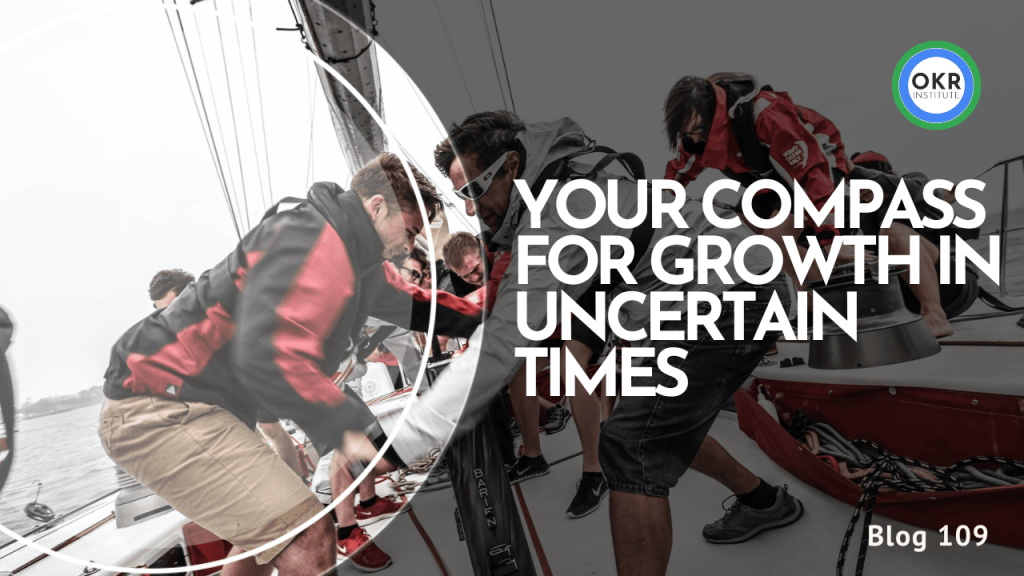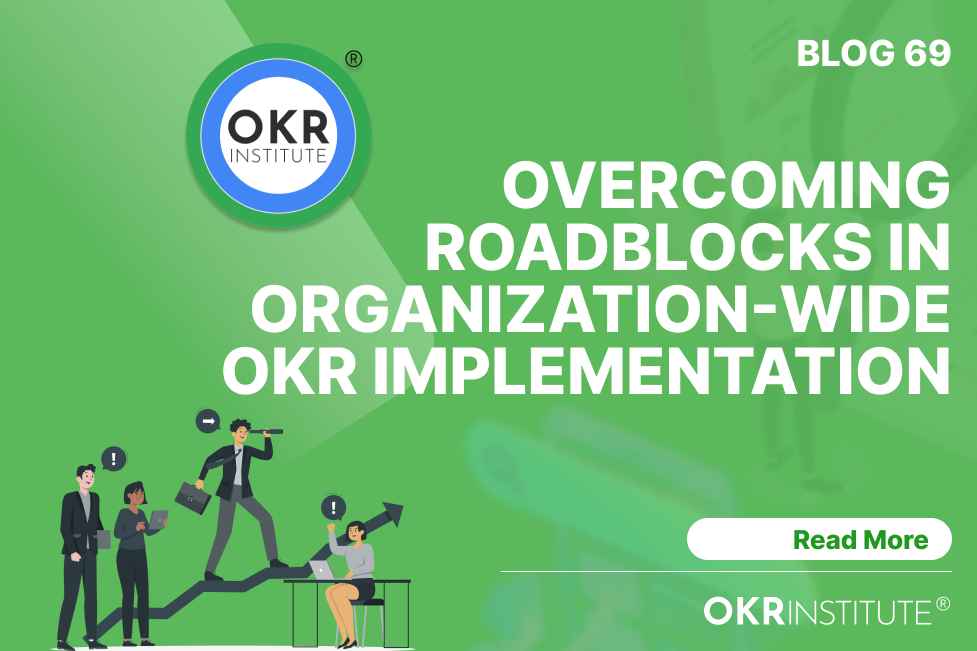Objectives and Key Results: Your Compass for Growth in Uncertain Times

Economic Challenges
Economic challenges such as recessions, inflation, and changes in consumer spending habits can have a significant impact on businesses. Recessions are characterized by a decline in economic activity, leading to decreased consumer spending, reduced demand for products and services, and potential job losses. This can result in decreased revenue, profits, and cash flow for businesses, making it difficult to sustain operations and growth.
Inflation, on the other hand, refers to a sustained increase in the general price level of goods and services. When inflation is high, it erodes the purchasing power of consumers, leading to reduced demand and potentially impacting sales and profitability for businesses. Additionally, inflation can increase operational costs, such as raw materials, labor, and overhead expenses, further squeezing profit margins.
Changes in consumer spending habits can also pose challenges for businesses. Shifts in consumer preferences, driven by factors such as technological advancements, social trends, or economic conditions, can render existing products or services less desirable. Businesses may need to adapt quickly to these changes by introducing new offerings, modifying existing ones, or exploring new markets to remain competitive and sustain growth.
These economic challenges can have far-reaching consequences for businesses, including decreased revenue, reduced profitability, cash flow constraints, layoffs, and even potential business closures in severe cases. Navigating these challenges requires strategic planning, agility, and a focus on aligning business objectives with the ever-changing economic landscape.
What are OKRs?
OKRs (Objectives and Key Results) is a goal-setting framework that helps organizations align their efforts and track progress towards achieving their objectives. The concept was first introduced by Intel and later popularized by companies like Google and LinkedIn.
At its core, the OKR framework consists of two components:
- Objectives: These are the qualitative, aspirational goals that an organization or team wants to achieve. Objectives should be inspiring, ambitious, and time-bound, typically spanning a quarter or a year.
- Key Results: Key Results are the quantitative, measurable outcomes that indicate progress towards the corresponding Objective. They should be specific, measurable, achievable, and relevant. Each Objective typically has 3-5 Key Results associated with it.
The OKR framework operates on a cadence, usually quarterly or annually, where teams set their Objectives and Key Results at the beginning of the cycle. Throughout the cycle, teams regularly track and measure their progress against the Key Results, making adjustments as needed. At the end of the cycle, teams reflect on their performance, celebrate successes, and identify areas for improvement.
The power of OKRs lies in their ability to foster alignment, focus, and transparency within an organization. By cascading Objectives from the top-level organizational goals down to individual teams and contributors, everyone understands how their work contributes to the overall mission. Additionally, the measurable nature of Key Results enables data-driven decision-making and continuous improvement.
Aligning OKRs with Economic Realities
Effective OKRs should be closely aligned with the prevailing economic conditions and market dynamics. During times of economic uncertainty or downturn, it becomes crucial to set realistic and achievable goals that account for the potential challenges and constraints. Here’s how OKRs can be tailored to navigate economic fluctuations:
Scenario Planning: Incorporate scenario planning into the OKR-setting process. Anticipate various economic scenarios, such as a recession, inflation, or shifts in consumer behavior, and develop corresponding OKRs that address these potential situations. This proactive approach ensures that your goals remain relevant and adaptable, regardless of the economic landscape.
Prioritization and Focus: Economic challenges often necessitate a sharper focus on core business operations and the most critical initiatives. Use OKRs to prioritize the key objectives that will drive growth, profitability, and resilience during tough times. Concentrate resources and efforts on the areas that will have the greatest impact on business sustainability.
Agile Goal-Setting: Embrace agility in your OKR-setting process. Rather than setting rigid annual goals, consider shorter cycles (e.g., quarterly or bi-annual) that allow for more frequent adjustments and course corrections based on evolving economic conditions. This flexibility enables you to respond swiftly to changes and realign your objectives as needed.
Cost Optimization: Incorporate cost optimization initiatives into your OKRs. During economic downturns, it’s essential to identify areas for cost savings, operational efficiencies, and resource optimization. Set specific OKRs around reducing expenses, streamlining processes, and optimizing resource allocation to maintain profitability and financial stability.
Customer-Centric Approach: Economic challenges can significantly impact customer behavior and purchasing power. Craft OKRs that prioritize understanding and addressing evolving customer needs, preferences, and budget constraints. Focus on delivering value, enhancing customer experience, and fostering loyalty to maintain a competitive edge.
Collaboration and Cross-Functional Alignment: Navigating economic challenges often requires cross-functional collaboration and alignment. Use OKRs to foster interdepartmental cooperation, break down silos, and ensure that teams are working towards shared goals that support the company’s overall economic resilience.
By aligning OKRs with economic realities, companies can proactively address challenges, optimize resource allocation, and maintain a strategic focus on the most critical objectives, ultimately increasing their chances of weathering economic storms and emerging stronger.
Focus and Prioritization with OKRs
One of the key advantages of implementing OKRs during economic fluctuations is the ability to focus efforts and resources on the most critical initiatives. When faced with economic challenges, it becomes crucial for businesses to prioritize their activities and allocate resources efficiently. OKRs provide a framework that helps organizations identify and concentrate on the objectives that drive the most value and impact.
By setting clear, measurable, and time-bound objectives, OKRs enable businesses to align their efforts towards achieving specific goals. This alignment ensures that resources, including time, money, and personnel, are directed towards the most important priorities, rather than being dispersed across multiple initiatives with varying levels of importance.
Additionally, OKRs encourage businesses to critically evaluate their spending and eliminate wasteful or non-essential expenditures. By regularly reviewing and assessing the progress towards OKRs, organizations can identify areas where resources are being underutilized or misallocated. This insight allows for the reallocation of resources to more productive and impactful initiatives, ultimately leading to cost savings and improved efficiency.
Furthermore, OKRs foster a culture of continuous improvement and agility. As economic conditions change, businesses can promptly adjust their OKRs to reflect new priorities and realign their efforts accordingly. This flexibility enables organizations to adapt quickly to market shifts, seize emerging opportunities, and mitigate potential risks, all while maintaining a sharp focus on their most critical objectives.
Transparency and Accountability
During times of economic uncertainty, transparency and accountability become even more crucial for organizations. OKRs foster an environment of openness and shared responsibility, enabling companies to navigate turbulent conditions more effectively.
With OKRs, objectives and key results are clearly defined and visible to everyone in the organization. This transparency ensures that all employees understand the company’s priorities and how their individual contributions align with the overarching goals. When economic conditions shift, OKRs provide a clear roadmap, allowing organizations to pivot and realign their efforts swiftly.
Moreover, OKRs promote a culture of accountability. By regularly tracking and reviewing progress against key results, organizations can quickly identify areas that require attention or course correction. This accountability helps organizations stay agile and responsive, making necessary adjustments to adapt to changing market conditions or customer needs.
During economic downturns, organizations often face difficult decisions, such as resource allocation or workforce adjustments. OKRs provide a data-driven framework for making these decisions objectively and transparently. By aligning OKRs with the organization’s strategic priorities, leaders can ensure that resources are allocated to the most critical areas, maximizing their impact and minimizing waste.
Furthermore, the transparency and accountability fostered by OKRs can help maintain employee engagement and morale during challenging times. When employees understand the company’s objectives and can see how their contributions make a difference, they are more likely to remain motivated and committed, even in the face of economic adversity.
Continuous Improvement and Agility
One of the key advantages of the OKR framework is its ability to foster a culture of continuous improvement and agility within an organization. In the face of economic fluctuations, businesses need to be able to adapt quickly to changing market conditions, consumer demands, and competitive landscapes. OKRs provide a structured approach to regularly review progress, identify areas for improvement, and make necessary adjustments to strategies and tactics.
By setting quarterly or annual objectives, teams are encouraged to continuously evaluate their performance and make data-driven decisions to course-correct as needed. This iterative process allows organizations to respond swiftly to shifts in the economic environment, such as changes in consumer spending habits or market trends.
Moreover, the transparent nature of OKRs facilitates cross-functional collaboration and knowledge sharing, enabling teams to learn from each other’s successes and challenges. This shared understanding of the organization’s objectives and key results fosters a sense of ownership and accountability, empowering employees to take proactive steps to address economic challenges.
The agile mindset promoted by OKRs also encourages a willingness to experiment and take calculated risks. During times of economic uncertainty, businesses that can quickly test and validate new ideas or pivots have a competitive advantage. By setting ambitious yet achievable goals, OKRs create an environment that embraces innovation and supports rapid iteration, allowing organizations to adapt and seize new opportunities as they arise.
Employee Engagement and Motivation
Economic downturns and market uncertainties can significantly impact employee morale and engagement. During challenging times, employees may feel demotivated, anxious about job security, or disconnected from the company’s goals. OKRs can serve as a powerful tool to keep employees engaged, motivated, and aligned with the organization’s priorities, even in the face of economic challenges.
By setting clear, measurable, and ambitious OKRs, employees can understand how their individual contributions directly impact the company’s success. This sense of purpose and ownership can foster a culture of accountability and drive, encouraging employees to stay focused and motivated despite external economic pressures.
Furthermore, OKRs promote transparency and open communication within the organization. Regular check-ins and progress updates on OKRs allow employees to see the tangible impact of their efforts and celebrate successes, boosting morale and reinforcing a sense of accomplishment.
Involving employees in the OKR-setting process can further enhance engagement and buy-in. When employees have a voice in defining their own goals and key results, they feel valued and empowered, leading to increased motivation and commitment to achieving those objectives.
Additionally, OKRs can facilitate cross-functional collaboration and teamwork. By aligning individual and team OKRs with the organization’s overarching objectives, employees can better understand how their roles contribute to the bigger picture. This interconnectedness fosters a sense of community and shared purpose, even during challenging economic times.
Overall, OKRs provide a framework for continuous learning, growth, and achievement, which can help maintain employee engagement and motivation, even in the face of economic uncertainties. By keeping employees focused, aligned, and invested in the company’s success, OKRs can be a powerful tool for navigating economic challenges while fostering a motivated and engaged workforce.
Data-Driven Decision Making
In times of economic volatility, businesses must make informed decisions to optimize their spending and resource allocation. OKRs provide a data-driven framework that enables organizations to make strategic choices based on measurable outcomes. By setting clear, quantifiable Objectives and tracking Key Results, companies can gain valuable insights into their performance, identify areas for improvement, and adjust their strategies accordingly.
OKRs foster a culture of transparency, where progress and challenges are openly shared and discussed. This transparency allows businesses to quickly identify areas where resources may be underutilized or where investments are not yielding desired returns. Armed with this data, organizations can make data-driven decisions to reallocate resources more effectively, cut unnecessary expenses, and focus on high-impact initiatives that drive growth and profitability.
Furthermore, OKRs promote continuous monitoring and adjustment, enabling businesses to adapt swiftly to changing economic conditions. By regularly reviewing and updating OKRs, companies can pivot their strategies, realign priorities, and respond proactively to emerging market trends or shifts in consumer behavior. This agility is crucial for navigating economic uncertainties and seizing new opportunities as they arise.
Overall, the data-driven approach of OKRs empowers businesses to make informed decisions, optimize spending, and allocate resources strategically, positioning them to weather economic storms and emerge stronger on the other side.
Driving Innovation with OKRs
Economic downturns and constraints often force businesses to become more innovative and seek new opportunities for growth. OKRs can be a powerful tool for driving innovation during challenging economic times by fostering a culture of experimentation, risk-taking, and continuous learning.
With OKRs, companies can set ambitious yet achievable goals that push teams to think outside the box and explore new ideas. By breaking down these goals into measurable key results, teams can track their progress and iterate quickly, allowing them to pivot or double down on successful initiatives.
Furthermore, the transparency and alignment inherent in the OKR framework encourage cross-functional collaboration and knowledge sharing. This can lead to unexpected synergies and insights, sparking innovative solutions that transcend traditional silos.
OKRs also help companies prioritize their innovation efforts by providing a clear focus on the most critical objectives. By aligning resources and efforts toward these objectives, businesses can maximize their chances of success, even with limited resources during economic constraints.
Moreover, the regular cadence of OKR cycles promotes a mindset of continuous improvement and learning. Teams can reflect on their successes and failures, identify areas for improvement, and quickly adapt their strategies, fostering an agile and innovative culture that thrives in uncertain economic conditions.
Overcoming Economic Challenges with OKRs
The OKR framework equips businesses with the agility and focus necessary to navigate economic fluctuations and seize growth opportunities. By aligning organizational objectives with measurable key results, OKRs provide a clear roadmap for adapting to changing market conditions and capitalizing on emerging trends.
During economic downturns, OKRs enable businesses to prioritize critical initiatives and allocate resources strategically. By focusing efforts on the most impactful objectives, companies can streamline operations, reduce costs, and maintain profitability. Additionally, the transparency and accountability fostered by OKRs empower teams to identify and address inefficiencies, further optimizing operations for challenging times.
Conversely, in periods of economic growth, OKRs facilitate the rapid scaling of successful initiatives and the pursuit of new opportunities. By continuously evaluating progress and adjusting course as needed, businesses can swiftly capitalize on favorable market conditions and outpace competitors. The data-driven approach of OKRs also informs strategic decision-making, ensuring investments align with organizational goals and market demands.
Moreover, the inherent flexibility of OKRs allows businesses to pivot and adapt their objectives as economic conditions evolve. This agility enables companies to stay ahead of the curve, anticipating and responding to market shifts proactively. By fostering a culture of continuous improvement and innovation, OKRs empower businesses to develop resilient strategies that withstand economic turbulence and drive sustainable growth.
CEO of the OKR Institute
Related Courses
Recent Posts
Tags
#OKR
#OKR Implementation
#Economic Challenges







